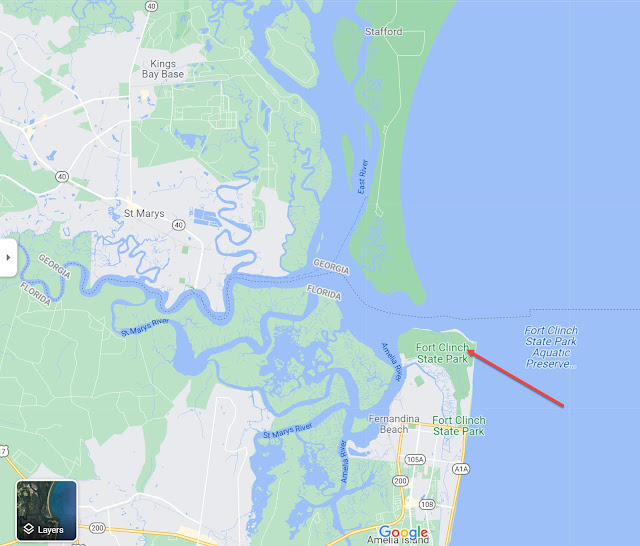Fort Clinch State Park is one of only two Florida state parks that are directly on the Atlantic Ocean and offer very close beach access, so it is one of my favorite stops. It is located as far north on the Atlantic as you can go in Florida without bumping into Georgia. As a matter of fact, you can see Georgia directly across the St. Mary's River, as shown here. The arrow shows the location of my campground.
I missed taking a photo of the campground entrance sign, but once I got past the entrance booth, I did take a photo of the two warnings signs about driving through the oak canopy. Actually, I noticed that in the two years since I have been here, the park service has done a lot of tree trimming, so I did not see any low limbs marked with yellow and black tape.
They still do, however, recommend you drive a big vehicle down the center of the road and watch out for low branches along the edge.
The specific oak trees that form this canopy are called "southern live oaks." Obviously, all oaks that are growing are "alive," but these oaks got their name because they do not lose their leaves in the winter, looking as if they are "live" while other oaks look dead without leaves. Live oaks can live several hundred years.
Live oaks also have another interesting characteristics--their branches tend to grow sideways, instead of more upright. The result is that many live oaks are wider than they are tall. The branches tend to form a tunnel or "canopy" by overhanging roads and paths. Sometimes, in the south you will see live oaks that have been planted along a roadway or estate entrance, but these are part of the natural woodland that makes up most of Fort Clinch State Park.
Oak canopies are great to drive through, especially when they have lots of Spanish moss hanging from them. They are prized wherever they are and are considered a precious natural resource.
Notice how low the branches of this oak are hanging over the road and how close the branch is to the edge of the road. This is a two-way road, so if another car comes toward you, it is best to slow down so you can drive down the middle.
The branch in the middle, but slightly to the right, is an entire tree. The main trunk must have died off at some time, but it certainly looks like this could come down in a heavy wind.
And more overhanging branches in the river campground. That campground is very heavily wooded and campsites are nicely shaded. However, I prefer the Atlantic Campground because it is closer to the beach and ocean.
And this is an armadillo. Or at least part of an armadillo. The front end is toward the right.
Armadillos do not pose for photos, and this guy was very busy snuffing the ground to find bugs and worms. But at least you can see the rear end of this one.











No comments:
Post a Comment